Translate this page into:
PBG & AGSM: Experience and challenges
Abstract
The modern generation fighter aircraft are capable of withstanding high G loads for long duration due to their higher thrust to weight ratio, low wing loading and high maneuverability. The futuristic super-maneuverable aircraft will add a new dimension to this by permitting accelerations in all the three axes and in varying attitudes of flight The electronic flight controls allow high +Gz to be built up at very rapid rates. While the aircraft structure has been strengthened and reinforced to withstand high G loads, the physiological abilities of the aircrew fall short. Beyond the innate tolerance, higher levels of +Gz stress can be tolerated only with the aid of one or a combination of interventions like the anti-G suit and anti-G valve, Positive Pressure Breathing for +Gz (PBG), tilt back seats and Anti-G Straining Manoeuvre (AGSM). In the present study, an attempt has been made to study the protection offered by a time-tested technique, AGSM and a new technique, the PBG used in conjunction with AGSM.
Keywords
PBG
AGSM
HSG
Supermanoeuverable aircraft
Acceleration stress is unavoidable in the flying milieu. It affects and limits the performance of the fighter pilot, when its effects on the physiological systems exceed the human tolerance and cause aircrew to lose consciousness while in a critical phase of flight. To achieve its roles, the fighter aircrew has to repeatedly man oeuvre the aircraft at high speeds to avail a position of advantage compared to his adversary while engaging him in aerial combat, to return to base after delivering a weapon and to attempt to save his aircraft from an adversary's missile. This exposes the aircrew to high radial accelerations and thereby to high levels of +Gz stress [1]. The modern generation fighter aircraft are capable of withstanding high G-loads for longer duration due to their higher thrust to weight ratio, low wing loading and high maneuverability. The futuristic super-maneuverable aircraft will add a new dimension to this by permitting acceleration in all the three axes and in varying attitudes of flight. The electronic flight controls allow high +Gz to be built up at very rapid rates. While the aircraft structure has been strengthened and reinforced to withstand high G-loads, the physiological abilities of the aircrew fall short. On exposure to higher G loads at rapid rates of onset (> 3 G/s), he may lapse into G-induced Loss of Consciousness (GLOC) [2] without the classical premonitory symptoms of greyout or blackout. The +Gz environment in a modern agile aircraft exposes the aircrew to peak G of the order of 7-10 G sustained for more than 15 seconds, with rapid onset and offset rates of 7-10 G/s [3, 4, 5, 6]. This happens in the critical phase of flight requiring undivided attention to details and may determine the success or failure of the mission. This has led to an interest and to the research into the methods of protection against these effects.
The exposure to High Sustained +Gz (HSG) affects predominantly the cardiovascular system. It causes immediate reduction in head level blood pressure. In addition, there is pooling of blood in the dependant parts, the abdomen and the inferior extremity. This decreases the venous return to the heart and consequently decreases cardiac output, which further reduces the head level blood pressure. This is a central concept and provides the physiological basis for intervention in +Gz stress. Beyond the innate tolerance, higher levels of +Gz stress can be tolerated only with the aid of one or a combination of interventions like the anti-G suit and anti-G valve, Positive Pressure Breathing for G (PBG), tilt back seats and Anti-G Straining Man oeuvre (AGSM) [7, 8, 9, 10, 11].
The alleviation of +Gz stress by supplementing the relaxed human tolerance to acceleration stress provides a strategy to cope with the problem in flight. The current day applied acceleration research centers around combining technology and evolve strategies to combat +Gz stress. In the present study, an attempt has been made to study the protection offered by a time -tested technique, AGSM and a new technique, the PBG [12, 13, 14] used in conjunction with AGSM.
The Advanced Fighter Aircrew Indoctrination Course (AFAIC) is being conducted at the Institute of Aerospace Medicine (IAM), Bangalore for fighter pilots of the Indian Air Force. It is mandatory for aircrew flying the high performance advanced fighter aircraft of the IAF like MiG - 29, Mirage - 2000 and Su - 30 [6].
Material and Methods
Subject. The subjects for the study were taken from the fighter pilots who reported to the IAM for the AFAIC.
Experience of Positive Pressure Breathing (PPB)
All subjects were initially indoctrinated on PPB through didactic interactive lectures and then given adequate exposure to PPB in the hypobaric chamber using the British Mk-21 regulator and ABEU mask in the Department of High Altitude Physiology and Hyperbaric Medicine of IAM. The manual selection of PBG using the switch on the regulator was practised on ground in the gondola of the centrifuge till the subject was proficient and confident of operating it. The subjects served as their own controls and were exposed to Simulated Aerial Combat Man oeuvre (SACM) and Gradual Onset Run (GOR) profiles with and without PBG. As all subjects were tested for both the +Gz alleviation techniques (AGSM and PBG), the need for randomization of subjects was obviated. To retain objectivity, some of the subjects were given the profiles with PBG before the profiles without PBG randomly. Care was taken to ensure adequate gap between the profiles to avoid erroneous results on this count.
Human Centrifuge. The human centrifuge was installed at IAM in 1966. It is microprocessor controlled and has a capability of providing multi-segmented G-profiles. It is equipped with a multi-channel micro-controller based digital data acquisition and retrieval system (DARE). A G-Nome software package helps in the on line monitoring and analysis of archived data.
Communication. The subject inside the gondola is monitored visually through two close circuit TV cameras, one of which can be selected at a time. A pair of low-intensity non-glare lights illuminates the interior of gondola to provide a view of the subject's face at all times. A two way open channel intercommunication facility is present between the medical controller and the subject.
Oxygen Regulator. A Mk-20A pressure demand oxygen regulator [15] was utilized for delivery of oxygen under pressure from a gasox cylinder. The knob needs to be pulled out prior to selecting the position. The position of the regulator giving 30 mm Hg pressure was calibrated (using a mercury manometer in parallel with the oxygen mask while in use by the subject), and was permanently etched on the regulator. The subjects were made conversant with the position and practiced its selection on ground to experience positive pressure breathing. The regulator is fitted on a steel bracket at a position in easy reach of the subject without compromising on the strapping up and on the safety during +Gz exposure.
Experimental Procedure (Methodology)
The subjects participating were available for experimentation at the Institute for two weeks from 0730 hrs to 1400 hrs. This permitted adequate indoctrination and interaction. The training schedule for the aircrew includes the following:
Indoctrination to AGSM by didactic lectures and demonstrations.
Indoctrination to PBG - Lectures followed by demonstrations.
SACM profiles performing AGSM.
GOR profile wearing anti-G suit.
SACM & GOR profiles along with PBG.
The protocol of the study was as follows:-
Pre-Test Precaution
The subjects were briefed thoroughly about the protocol of the study. A detailed medical history, including flying history, previous exposure to centrifuge runs was obtained. Details regarding giddiness, faintness, motion sickness and G-LOC were also elicited. It was ensured that the subjects were not on any medication. This was followed by a thorough medical examination. All the runs were conducted between 0800 - 1200 hrs to avoid any possible variations due to circadian rhythm. The subjects were advised to refrain from alcohol, have adequate night sleep and a standard breakfast before the runs.
Pre-Test Instruction
Indoctrination of the Human Centrifuge. The subjects were instructed about the method of simulation of +Gz stress in the human centrifuge. The indoctrination involved:
Appraisal of the capabilities, safety features and limitations of the human centrifuge.
Demonstration of the facilities on the gondola, location of switches, monitors, probes and controls.
The details of the profiles - onset rate, peak G, offset rate and actions to be performed during the run.
Task to be performed while under +Gz stress - Switching off the lights of Graduated Dynamic End Point System (GRADEPS), and calling out at specific points during the run.
Emergency drill - The subjects were instructed to switch off the auditory alarm on hearing it.
AGSM Indoctrination. The subjects were taught how to perform AGSM (the LI variant) to increase their +Gz tolerance. This indoctrination is a part of the AFAIC; the subjects were instructed that there are two distinct parts of the AGSM, the breathing and the muscle tensing. For the breathing, the subject on the count of '1' took a quick inhalation, followed by a forceful expiratory effort against a closed glottis for 3 seconds, and then a short forceful exhalation and inhalation. The counts were given by the Instructor and were timed “1-2-3-4” in quick succession over a period of 4 seconds. For the muscle tensing, the subject tenses up all the muscles of the body simultaneously in a sustained isometric muscular contraction.
Indoctrination to PBG. Positive Pressure Breathing (PBG) as a concept is introduced to the subjects after AGSM indoctrination as an additional method of +Gz protection. This is followed by an experience of PPB at ground conditions with the Mk 21 regulator and 'P' mask. The important issues stressed here are that the exhalation is active and requires effort and adjustment; the mask seal should be adequately tight so it does not give way under higher pressures and the need for toggle down position during the actual runs to ensure adequate seal.
Preparation/Instrumentation of the Subject
Clothing. The subjects wore the standard flying overall and an anti-G suit (indigenous ABEU Mk -II cutaway type / Russian PPK-1Y) along with their own flying boots. For the PBG runs, the additional clothing in the form of inner helmet and 'P' type oronasal mask was also worn. The inner helmet provides the attachments for the restraint of the oronasal mask.
The resting heart rate and blood pressure were recorded. The areas of the anterior chest wall where the disposable electrodes were to be placed were shaved. The areas were cleaned with spirit or acetone solution till the superficial layer of epidermis was removed. The disposable electrodes were placed in the following areas to form the configuration of CM5 (indifferent electrode is placed at manubrium sterni, the exploring electrode is placed at V5, which is at the left 5th intercostals space in the anterior auxiliary line) and CC5 (indifferent electrode is placed at the right 5th intercostals space in the midaxillary line, the exploring electrode is placed at the left 5th intercostals space in the anterior axillaries line) lead systems. There is a common neutral electrode, which is placed on the right iliac region. The electrodes were then connected. The resting heart rate and blood pressure were recorded.
The subject was then seated in the gondola with the seat back angle of 13°. The valve cuts in at 2G, and supplies pressure at the rate of about lpsi/G above 2 G. The electrodes were connected to the computer inside the gondola...The ECG was recorded in CM5 and CC5 lead, system. After confirmation of good quality recording, the resting ECG was recorded for few minutes.
The subject after instrumentation and positioning in the gondola was asked to practice switching off the peripheral lights of the modified GRADEPS as soon as they appeared, while fixing his gaze on the central red light. He also practiced switching off the audio horn, which would be used during the actual run in case of G-LOC.
The Centrifuge Profiles
All the subjects were exposed to increasing +GZ levels during the duration of the course. These included high-G runs of 7G for 15s, 8G for 10s and 9G for 5s and SACM. For the SACM / SACM-PBG runs, the profiles were as follows:
A warm up run was given at onset rate of lG/sec, the peak being 4G for 15 sec followed : y offset rate of -0.5G/sec upto 2G, after 4sec at 2G, the centrifuge decelerated at -0.2G/sec.
SACM run: The SACM profile (Fig 1) consisted of an onset rate of lG/sec up to 4G, stay tt 4G for 15 sec, then again build up at the rate of lG/sec to 8G and stay at 8G for 10 sec. This was followed by an offset rate of lG/sec to 4G and stay at 4G for 15 sec. This peak of 4G - 8G was repeated and continued till the subject felt fatigued and gave a call to terminate the run. The profile was automatically terminated at the end of 300 seconds or 9 peaks of 8G for 10 seconds each. This limit of 300 seconds has been kept, as the aircrew is not likely to exceed this limit in a combat sortie in real life and also as it gives adequate exposure for experience on ground. To enable analysis of subjects who complete this criterion, and could have continued i.e. their fatigue level had' not set in, subjective inputs were also taken from the subjects. Also their heart rate from the ECG archive were analyzed to study the change, if any, at various phases of the profile.
SACM - PBG Profiles: The profile for SACM - PBG (Fig 2) run is identical to the SACM profile with the only instruction to the subject to select the PBG at 4G. This command is given to the individual after the anti-G suit has inflated. He selects the PBG as instructed and it gives him a continuous 30 mm Hg positive pressure throughout the profile. At the end of the profile, he is asked to put the PBG off and remove the mask.
GOR profile : The profile (Fig 3) consists of an onset rate of 0.1 G/s, peak of 9G, plateau phase of 2s and an offset rate of -lG/s upto 2G; after 4s at 2G level, the rate of offset was -0.2 G/ s to baseline. The subject was instructed to remain totally relaxed to start with, only switching off the PLL system lights. He was instructed to give a call when the anti-G suit inflates (around 2G); thereafter remains relaxed till he has a grey out, when he calls out 'Now'. This is recorded as his relaxed GOR tolerance. Then he starts performing AGSM to the counts given by the medical controller and calls out 'Now' if and when he has a second grey out despite performing AGSM. This is recorded as his straining GOR tolerance. In case he has a second grey out, he is instructed to continue straining and the medical controller brings down the centrifuge using a switch available to him. There were subjects who completed the profile till 9G, and could have continued, i.e. their fatigue level had not set in. To be able to assess these subjects also, the subjective inputs were also taken from the subjects. Also their heart rates from the ECG archive were analyzed to study any change in heart rate in various phases of the run.
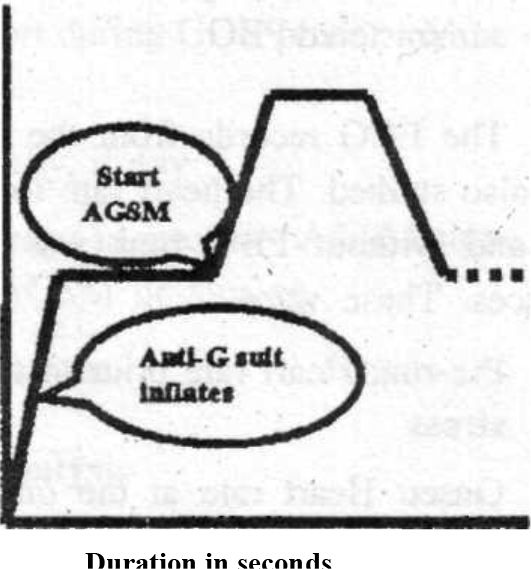
- SACM
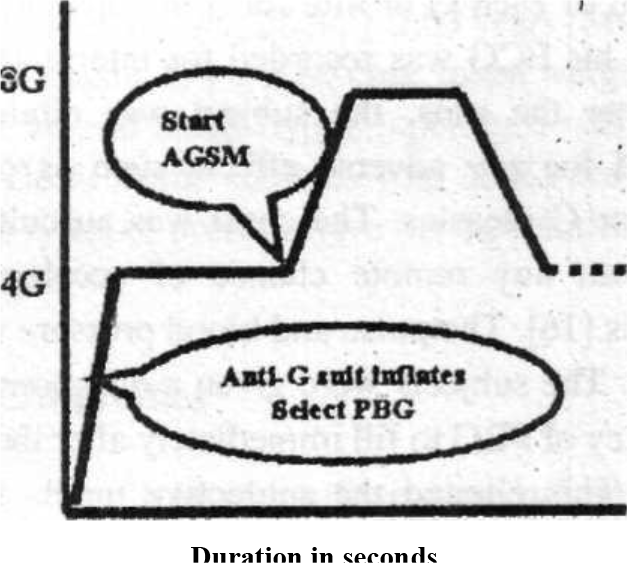
- SACM-PBG
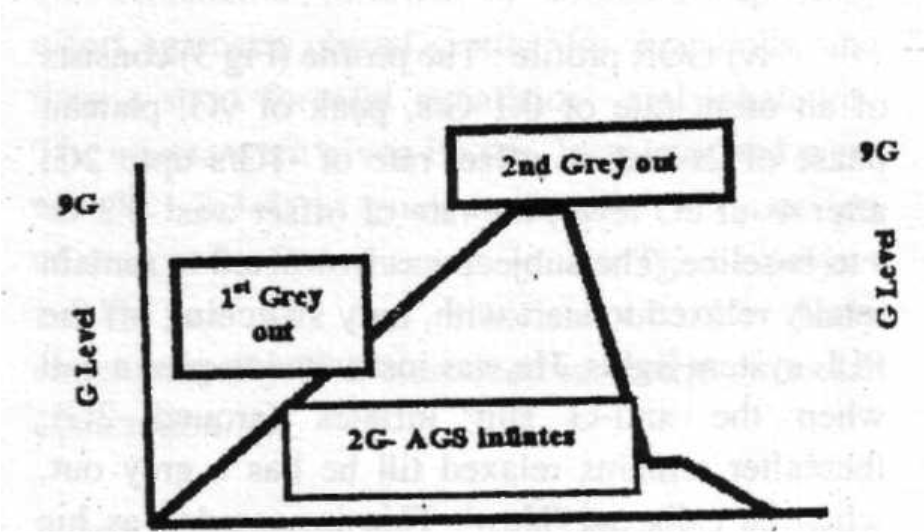
- GOR profile
Data collection
The proformas were analyzed. These have the recordings of the profile detail, G-onset rate, peak G, G-offset rate, duration of profile, AGSM
v) GOR-PBG profile: This profile (Fig 4) is similar to the GOR profile above, except that the subject after confirming anti-G suit inflation selects the PBG on. The GOR relaxed and straining was recorded similarly.
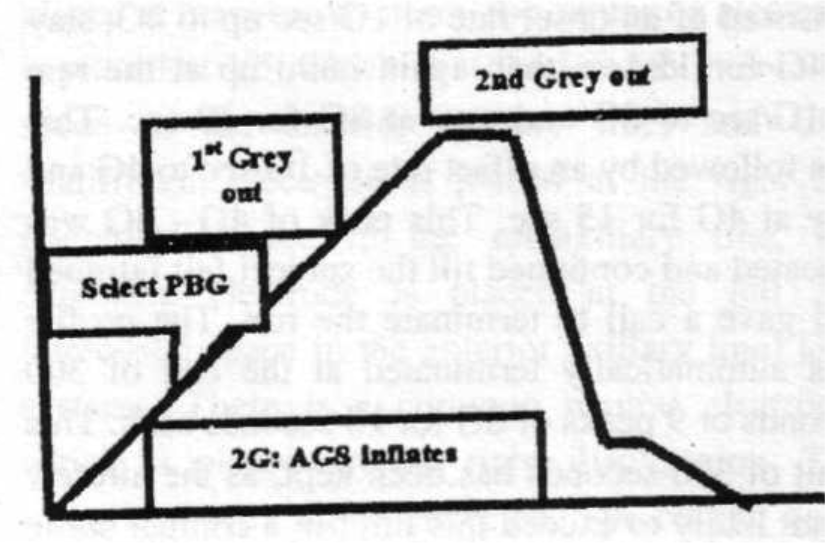
- GOR-PBG profile
Post-G Run Protocol
The subject remained seated in the gondola at the end of each G profile for 5 minutes; during this time his ECG was recorded for interpretation later. After the runs, the subject was clinically examined for any adverse effects such as pedal oedema or G measles. The chest was auscultator to rule out any remote chance of acceleration atelectasis [16]. The pulse and blood pressure were recorded. The subjects were given a questionnaire for efficacy of PBG to fill immediately after the test profiles. This elicited the subjective inputs from them regarding comfort/difficulty, comparison of the runs with and without PBG and their valuable suggestions.
PBG done and any difficulty experienced. This was reduced to the following data:
SACM tolerance time performing AGSM and SACM tolerance performing AGSM and being concurrently given PBG
GOR relaxed and straining tolerance wearing anti-G suit and GOR relaxed and straining tolerance wearing anti-G suit and being administered PBG
The ECG records from the archived data were also studied. The heart rate for SACM runs with and without PBG runs was noted at six instances. These were:
Pre-run: Heart rate prior to the onset of G stress
Onset: Heart rate at the onset of SACM peak (4G - 8G)
Maximum: The maximum heart rate achieved in the profile
Offset: Heart rate immediately after the offset
Post-run: Heart rate immediately after the run
5 min post-run: Heart rate five minutes after the run
For the GOR profiles wearing anti-G suit and GOR profiles wearing anti-G suit and being •administered PBG runs, the following heart rate were recorded from the hard disk of the computer:
Pre-run: Heart rate prior to the onset of G stress
Maximum: The maximum heart rate achieved in the profile
Post-run: Heart rate immediately after the run
5 min post-run: Heart rate five minutes after the run
Administering a questionnaire provided a subjective assessment of the two personal protective procedures. This included the assessment of PBG in the following manner:
Comfort during SACM profile - More / Same / Less
Comfort during GOR profile - More / Same / Less
Difficulty, if any
Preference in aircraft - AGSM alone / PBG with AGSM or tensing
Suggestions
Statistical Analysis
The SACM profile data with and without PBG were analyzed in terms of the duration at -CM. These give an estimate of the G-duration tolerance. There was however a subset of individuals who completed more than 300 seconds or 9 peaks. To obviate this anomaly, the heart rate obtained from various phases of the SACM profile were compared against the corresponding heart rate obtained in the SACM - PBG profiles using 'Z' test.
For the GOR runs, the relaxed and straining G tolerance levels obtained with and without PBG were compared. This gave an estimate of G-level tolerance. Also, the heart rate of various phases of GOR run was compared with the corresponding values of GOR runs with PBG.
The subjective symptoms and observations of the subjects are also enumerated and analyzed.
Results
The experimental data was collected between August 1998 and May 2000 under similar data collection conditions between 0900 h and 1300 h on all subjects. All known extraneous influences, which could have influenced the experimental protocol, were minimized and factors affecting the G tolerance other than the ones being tested were kept identical.
Thirty-eight (38) healthy male volunteer subjects were exposed to the profiles in the study. This mean age was 26.34 ± 2.03 years (Mean + SD), mean height 174 + 5.86 cms, mean weight 66.39 + 7.21 kg and mean flying experience was 588.61 + 294.58 h. Some subjects who could not complete both types of profiles have been excluded from the study.
SACM profdes
The SACM profiles were administered to assess the difference in the G-time tolerance of the subject while performing AGSM alone and while performing AGSM and simultaneously being administered PBG. The profile selected was a 4G - 8G SACM. The following findings were noted:
The mean duration of SACM performing AGSM was noted to be 174.23 ± 91.82s (Mean ± SD). In SACM runs performing AGSM and simultaneous PBG application, mean SACM tolerance time was 214.62 ± 96.19 s. This difference in the duration of SACM of 40 s is significant (p<0.001) (Fig 5).
The heart rate records of 38 subjects during pre-run, onset, maximum, offset, post-run and five minute post run phase of SACM profile performing AGSM and corresponding heart rate of the same subjects during SACM profile performing AGSM and being administered PBG are graphically represented in Fig 6. The analysis reveals that there is significant reduction (p<0.001) in the maximum heart rate, 166.38 + 19.32 achieved during the administered PBG as compared to maximum heart rate, 177.85 ± 18.9 achieved in SACM profile performing AGSM alone. During all other phases, where the heart rate was compared, the difference was not significant. GOR profiles
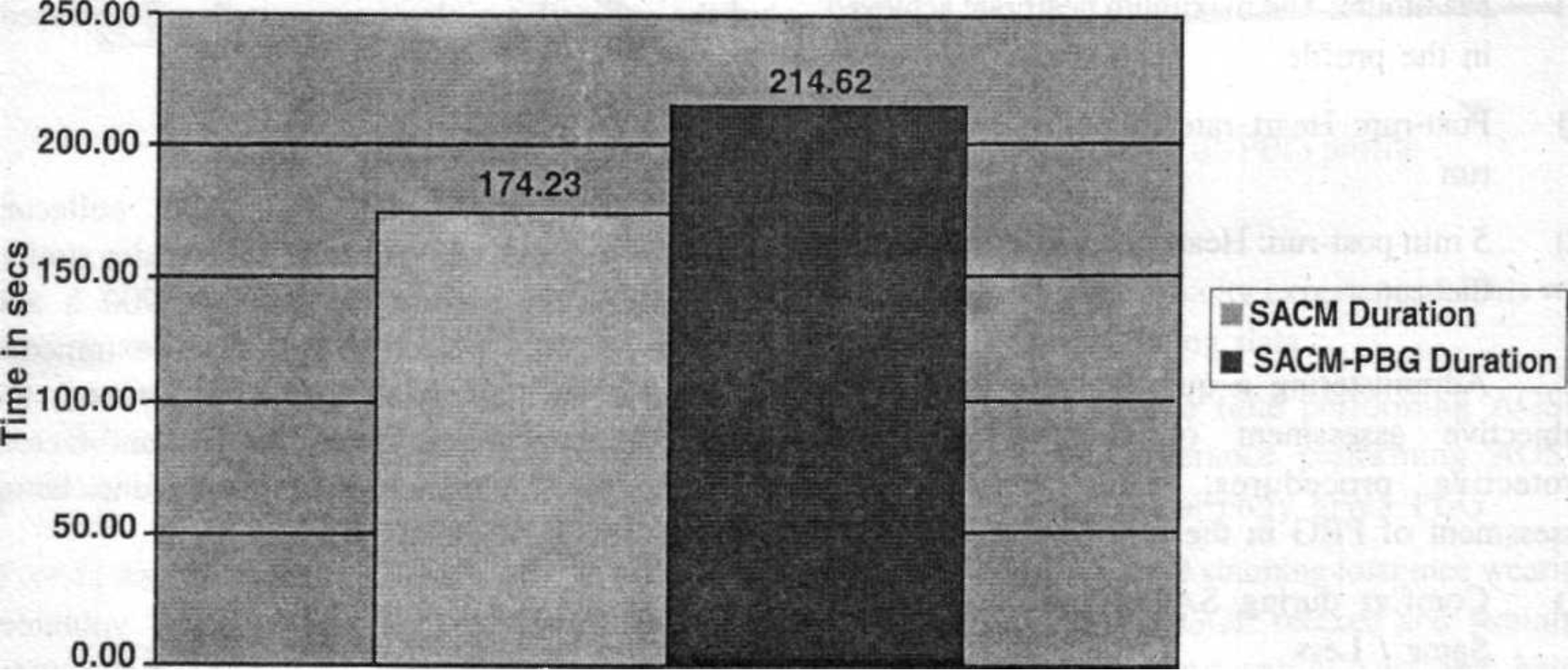
- Duration at SACM in seconds (n=38)
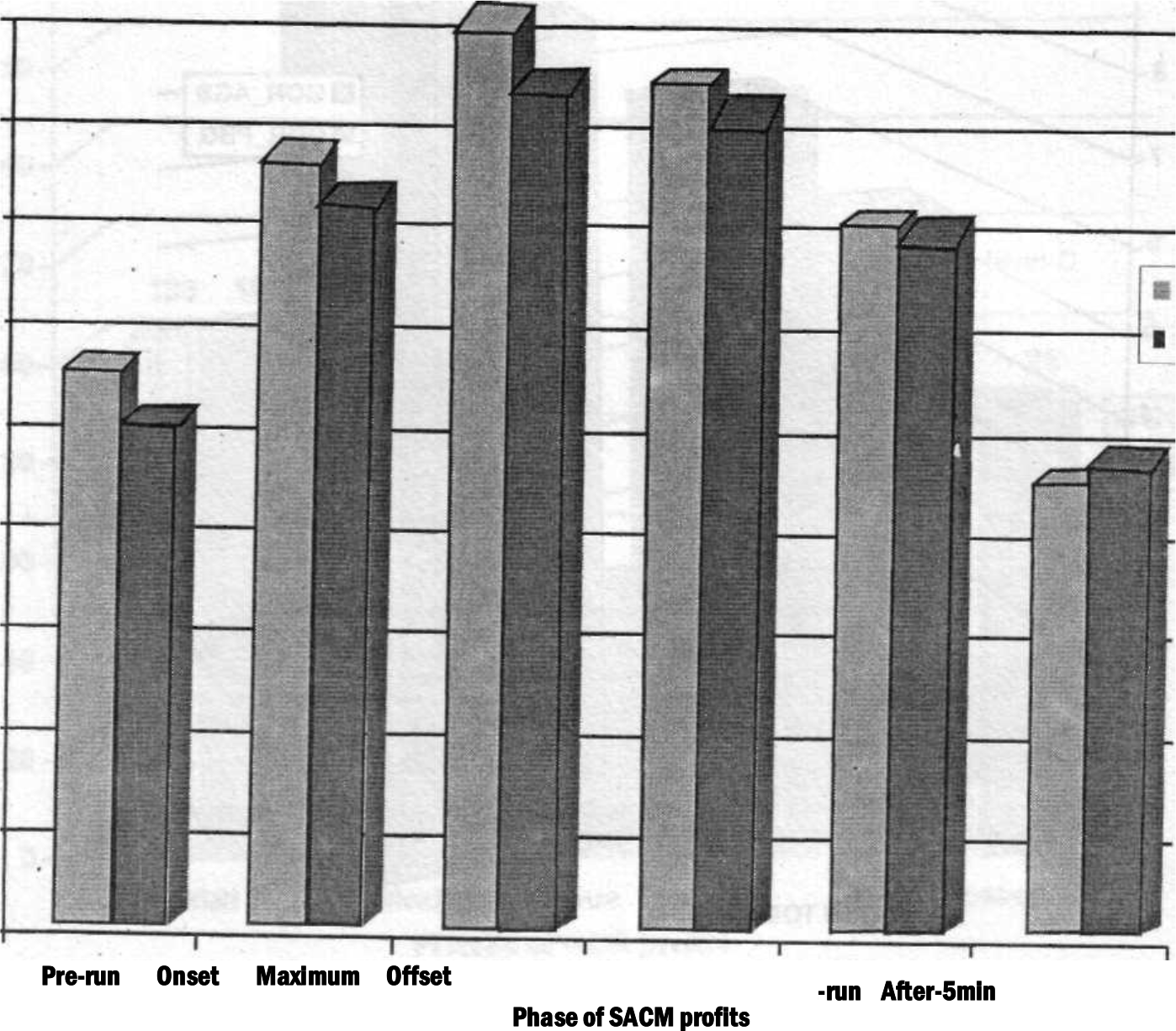
- Heart rates in phases of SACM with AGSM vs. SACM profiles with AGSM and PBG (n=38) Gradual Onset Rate (GOR) Profiles
The GOR profiles were administered to assess the difference in the G-level tolerance of the subject while undergoing GOR profile wearing anti-G suit and GOR profile wearing anti-G suit and SACM profile performing AGSM and being simultaneously being administered PBG. The profile selected was a 9G GOR profile with an onset rate of O.lG/s and an offset rate of lG/s. The profile is limited to a maximum of 9G for 02 seconds. The GOR relaxed and straining tolerance was recorded for each of the GOR profiles.
-
The mean relaxed GOR tolerance was noted to be 6.16 + 0.92 G. The mean relaxed GOR while being administered PBG simultaneously was 6.71 ± 0.68 G. This difference in the relaxed GOR: tolerance of 0.55 G was highly^ignificant (p<0.001) Fig 7).
wearing anti-G suit was 2.75 G. This difference in relaxed and straining tolerance was statistically significant at p=0.001 (Fig 7).
The mean straining GOR tolerance was noted to be 8.91 + 0.37G. The mean straining GOR tolerance while being administered PBG simultaneously was 8.95 + 0.68 G. This difference in the straining GOR tolerance of 0.04G was not significant at p=0.05 (Fig 7).
The difference between relaxed GOR ■.earning anti-G suit and straining GOR tolerance
The difference between relaxed GOR tolerance wearing anti-G suit and being administered PBG and straining GOR tolerance wearing anti-G suit and being administered PBG was 2.24 G. This difference in relaxed and straining tolerance was statistically significant at p=0.001 (Fig 7).
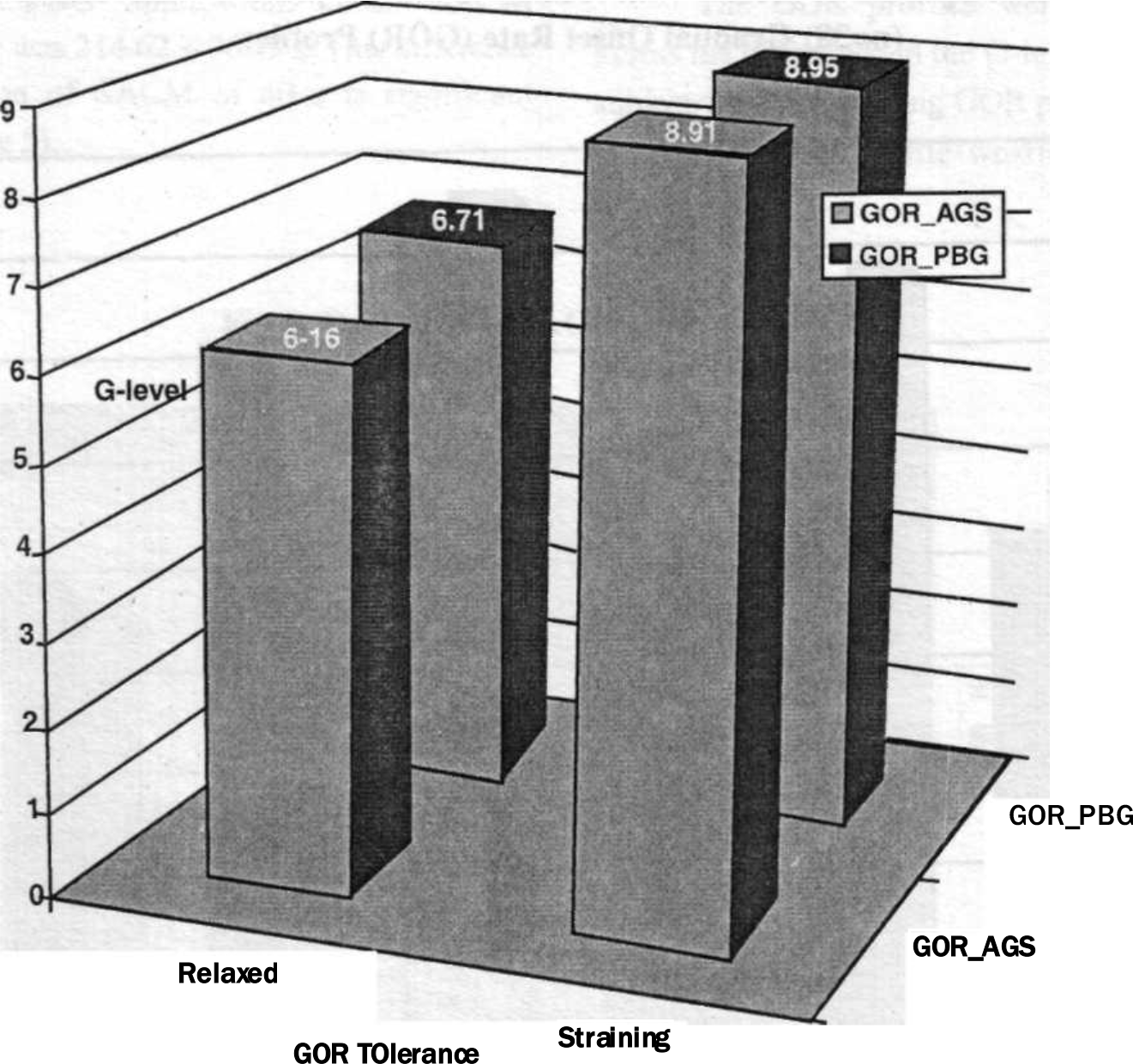
- Relaxed and straining GOR tolerance wearing anti-G suit alone vs anti-G suit and PBG (n = 38)
The heart rate during pre-run, maximum, post-run and five-minute post-run phase of GOR wearing anti-G suit and corresponding heart rate end of the runs. The following information was for GOR wearing anti-G suit and being administered derived from the questionnaires.
PBG are graphically represented in Fig 8. Analysis reveals that there is significant reduction (p<0.001) in the post run heart rate from 145.39 + 21.23 in comparison to the heart rate in the corresponding GOR run with PBG 140.08 ± 21.23. During all other phases of the profile studied, the difference was not significant.
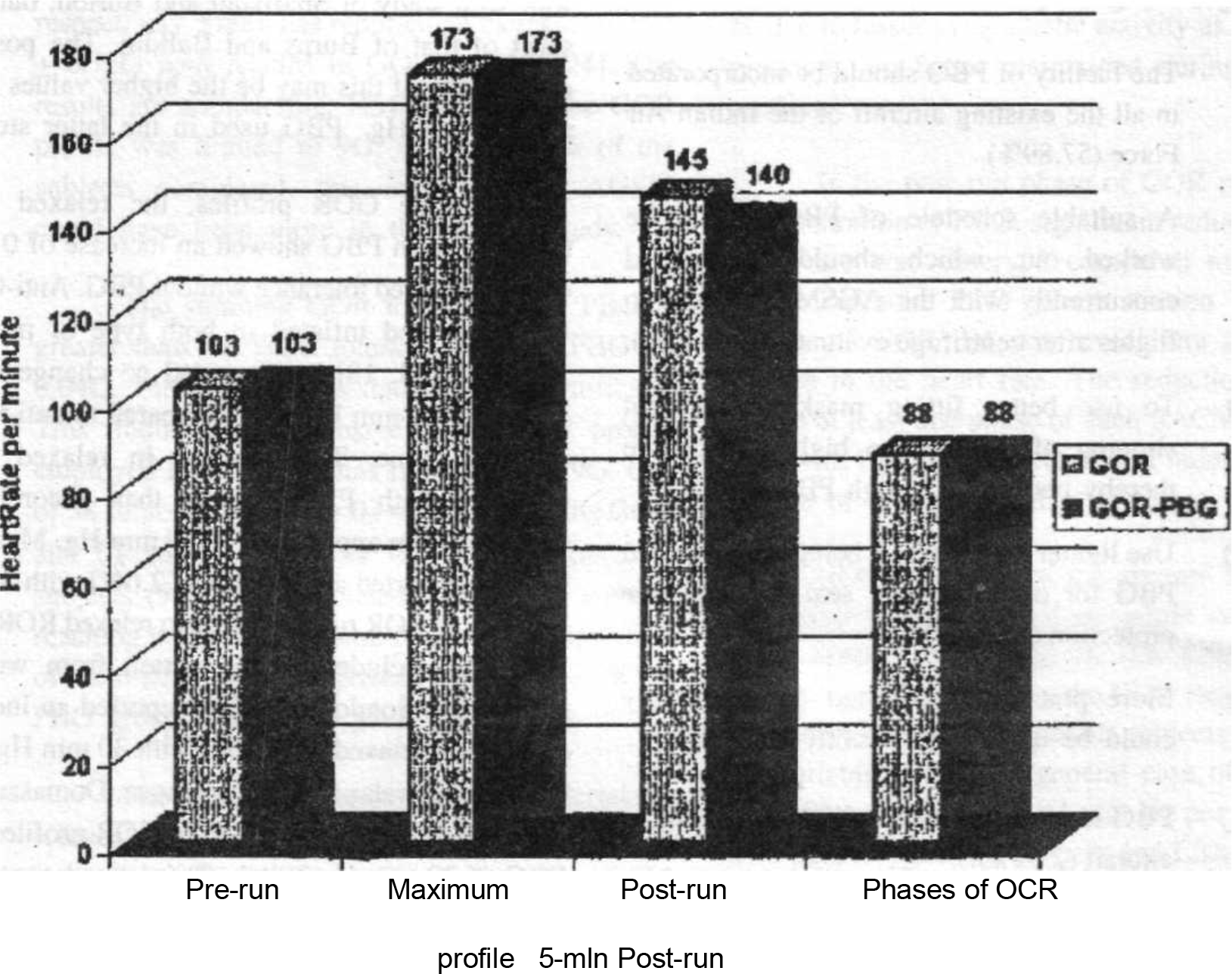
- Heart rates in phases of GOR tolerance wearing anti-G suit vs. anti-G suit and PBG (n = 38)
Subjective Evaluation
The aircrew subjects who underwent the profiles were administered a questionnaire at the
68.42% subjects were more comfortable in SACM profile with concurrent administration of PBG compared to SACM profile without PBG, 21.06% felt there was no difference between the two SACM profiles and only 10.52% of the subjects felt that the SACM profile with anti-G suit and PBG was less comfortable than SACM profile with anti-G suit alone.
78.94% subjects felt that their G-duration tolerance was more in SACM profile performing AGSM and being administered PBG compared to SACM profile performing AGSM alone. 13.15% felt no change between the SACM (29/38) felt less fatigue during SACM profile performing AGSM and being administered PBG profiles and 7.8% felt that their- tolerance was lesser with SACM profile performing AGSM and being administered PBG as compared to SACM profile performing AGSM alone.
15.78% (6/38) subjects felt that the fatigue associated with SACM profile performing AGSM and being administered PBG was more compared to SACM profile performing AGSM alone. 7.89% (3/38) of the subjects felt no difference between the two SACM profiles. 76.31% compared to SACM profile performing AGSM alone.
The difficulties perceived during the profile were only two: first, the exhalation phase of breathing was more difficult in 63.16% (24/38) subjects and secondly, the mask kept slipping down at higher G levels in 31.58% (12/38) subjects.
Asked whether they would prefer AGSM alone or PBG with AGSM in the aircraft, 18.42% (7/38) subjects preferred AGSM alone whereas 81.58% (31/38) of the subjects preferred a combination of PBG and AGSM or muscle tensing.
-
Other suggestions put forth by the subjects (fighter pilots) were as follows:-
The facility of PBG should be incorporated in all the existing aircraft of the Indian Air Force (57.89%).
A suitable schedule of PBG should be worked out, which should be applied concurrently with the AGSM and used in flights after centrifuge evaluation (47.36%).
To use better fitting masks to prevent slipping off during the high G exposure thereby permitting a high PBG (50%).
Use lighter masks while being administered PBG for optimum face seal and effective protection (26.31%).
More practice is required before facility could be used in an aircraft (44.73%).
PBG is of no practical utility for the use in aircraft (2.63%).
Discussion
This study found an enhancement of G-duration tolerance of 23.18% (40 seconds) in the 4G - 8G SACM profile performing AGSM and being administered PBG of 30 mm Hg as compared to SACM with AGSM alone. Shaffstal and Burton have reported a 27% increase in the 4.5G - 7G SACM duration with 30 mm Hg balanced PBG in 1982 [17]. Tolerance time with unbalanced PBG of 30 mm Hg was identical to subjects wearing anti-G suit and performing M-l AGSM [3, 17]. Burns and Balldin [11], in 5G-9G SACM profiles using 50 and 80 mm Hg of PBG cutting in at 1.2G and increasing linearly to maximum value have reported 108% and 88% increase in the G-duration respectively over subject only wearing the anti-G suit. The increase in the +Gz protection offered by PBG during SACM in the current study correlates well with study of Shaffstall and Burton, but falls short of that of Burns and Balldin. The possible explanation of this may be the higher values of 50 and 70 mm Hg PBG used in the latter study.
In the GOR profiles, the relaxed GOR tolerance with PBG showed an increase of 0.55 G over the relaxed tolerance without PBG. Anti-G suit was worn and inflated in both type of profiles. Shubrooks [3, 18] has reported no change in the PLL with 40 mm Hg PPB compared to anti-G suit inflation alone. The increase in relaxed GOR tolerance with PBG is less than theoretically expected from application of 30 mm Hg. Marwaha [20] has reported an increase of 2 - itfa 30 mm Hg PBG in ROR run compared to relaxed ROR runs. This also includes the protection from wearing anti-G suit. Sondoyi [20] has reported an increase of 0.4 G in relaxed ROR runs with 30 mm Hg PBG compared to relaxed ROR tolerance. Domaszuk has reported an increase of 1.8 G in GOR profiles with PBG of 30 mm Hg being administered constantly over controls [21]. Bagshaw has reported 0.5 G and' 1.3 G increase in G tolerance in ROR profiles with PBG of 18 and 38 mm Hg cutting in at 3.3G [22]. Rai has studied 10, 20 and 30 mm Hg PBG in ROR profiles with and without a partial pressure (capstan) suit. He reported an increase of 0, 0.44 and 0.80 G in the three PBG schedules respectively as compared to the partial pressure suit tolerance value [23]. The lesser than expected increase in the G-level tolerance could be due to the absence of counter pressure garments, which limit lung expansion and reduce fatigue [3]. The results of Sondoyi [20], Marwaha [19] and Rai [23] are comparable with the current study. The better results of Bagshaw could be attributed to the higher PPB level.
The increase in G-level tolerance with AGSM was found to be 2.75G and 2.24G in profiles with and without 30 mm Hg continuous PBG respectively. Malik has reported an increase of 2.93 ± 0.76G with AGSM in GOR profiles [24]. The results are comparable. However, since the GOR profile was limited to 9G, which 94.73% of the subjects completed, this increase with AGSM could have been more in the present study.
The straining GOR tolerance with PBG is greater than the GOR tolerance without PBG by 0.04G. This difference is statistically insignificant. This finding is inconclusive as the GOR profile employed in this study has fixed peak of 9G. Out of 38 subjects, except for 03 subjects from the GOR and 01 subject from the GOR-PBG group, all subjects (94.73%) completed 9G profiles without reaching their fatigue point. It is evident that some of them from each and possibly more from GORPBG group could have gone beyond 9G.
The analysis of heart rate was undertaken. It revealed a significant reduction in maximum heart rate achieved in SACM profiles performing AGSM and being administered PBG as compared to the SACM profiles performing AGSM alone. The heart rate at all the other phases of the profiles studied did not reveal any significant change. Shaffstal and Burton have reported no significant change in heart rate of subjects being administered unassisted or balanced PBG compared to subject performing M-l AGSM [3]. Shaffstall and Burton in their study of 30 mm Hg PBG with different flying clothing assemblies, have found no difference in heart rate of subjects being administered PBG with different flying clothing assemblies, and have found no difference in heart rate of subjects being administered PBG compared to the control group without PBG [3]. Domaszuk has reported a reduction in heart rate during GOR profile while being administered PBG as compared to GOR without PBG. His profile consisted of an onset rate of 0.2G till 5G and thereafter constant 5G till fatigue [21]. The lesser rise in heart rate with PBG could be due to lesser sympathetic activity as the arterial pressures are better maintained during the PBG profiles.
In the post-run phase of GOR profile with administration of PBG, significant reduction in the heart rate was observed compared to the GOR profile without PBG administration. All other phases of GOR did not reveal any appreciable change in the heart rate. The reduction of heart rate in at least one phase of each SACM and GOR runs with PBG is interpreted as a reduction in the fatigue of the individual.
68.42% (26/38) of the aircrew felt AGSM was easy when it was done while concurrently being administered PBG. 76.31% (29/38) of the aircrew had less fatigue in the GOR run with PBG. Chambers had reported that his subjects were more comfortable and had a general ease of breathing in profiles with PBG of 1.4 mm Hg per G upto 5G with pure oxygen [3]. Glaister and Lisher reported that their subjects found PBG more acceptable and comfortable than AGSM in a profile of 5 mm Hg per G starting at 2G [3]. The subjects in the current study found continuous application of 30 mm Hg PBG comfortable (68.42%), less fatiguing (76.31%) and that it increases the G-duration tolerance (78.94%). Harding [25] attributes the beneficial effects of PBG to the reduction of fatigue otherwise caused by AGSM.
The difficulties faced by the subjects during the PBG runs were chiefly in expiration (68.16%) and the mask slippage (31.59%). The exhalation becomes an active forceful process in PPB and that is novel to the body. This difficulty could be surmounted by more practice and adequate ground exposure. With excessive pressures being developed in the mask, its slippage and hence a compromise in the facility of PBG is envisaged. Proper sizing and fitment use of tightening devices ^nd frequent use shall overcome this problem.
Among the suggestions elicited from the subjects, most (57.89%) aircrew suggested use of PBG in the aircraft as a synergistic method to AGSM and use of better masks. Most workers have reported the best protection and pilot acceptability between 30-60 mm Hg [26, 2, and 27]. At pressures higher than this, the discomfort caused to the aircrew outweighs the beneficial effect of PBG [3, 1, and 27].
It was also suggested that more profiles be worked out and evaluated prior to adaptation to the aircraft. One aircrew (2.63%) felt that ‘the PBG facility is redundant. This opinion is most likely because of the absence of the facility of PBG in most IAF aircraft at present and likely to change with its incorporation in the aircraft. The Su-30. already has the facility [28] and the indigenous Light Combat Aircraft (LCA) shall have it. PBG was found to be useful adjunct to AGSM in enhancing the +Gz tolerance. It is helpful in AGSM by making .the inspiration effortless and there by reducing fatigue.
The present study has quantified the benefits of PBG along with AGSM utilizing a 30 mm Hg continuous PBG being selected manually by the subject. Despite the constraints of such a study design, the results have been encouraging. From the feedback of the aircrew subjects, it is evident that the technique shall be well accepted, if and when it is incorporated in the aircraft.
References
- “Evaluation of Six G Protection Ensembles during 5 to 9G Simulated Aerial Combat Man oeuvres”. SAFE Journal. 1997;27(2):92-99.
- [Google Scholar]
- “High G physiological protection training”. AGAR Dograph. No 322 Neuilly sur Sienne
- [Google Scholar]
- 1984 “A flight trial of positive pressure breathing during acceleration using RAF Hawk aircraft at a tactical weapons unit". Royal Air Force, Institute of Aviation Medicine. IAM Report No. 637, locsit AGAR Dograph 322, High G Physiological Protection Training. :85.
- [Google Scholar]
- 1988 “+Gz protection and assisted positive pressure breathing”. Aviat Space Environ Med. ;59:225-233.
- [Google Scholar]
- “Current status of acute high-G physiology” The Physiologist. . 1991;34(1)(Supplement):S11-S14.
- [Google Scholar]
- “G induced loss of consciousness: definition, history, current status”. Aviat Space Environ Med. 1988;59:2-5.
- [Google Scholar]
- 1975 “G-tolerance and protection associated with anti-G concept”. Aviat Space Environ Med. ;46:119-124.
- [Google Scholar]
- 1974 “Man at high sustained +Gz acceleration: A review”. Aviat Space Environ Med. ;45:1115-1136.
- [Google Scholar]
- “Biodynamic of sustained acceleration”, Chapter 9 in Fundamentals of Aerospace Medicine. Baltimore Williams & Wilkins; :201-260.
- [Google Scholar]
- “Effects of radial, angular and transverse acceleration” Aerospace Medicine, 2nd ed Vol 971. Baltimore: Williams and Wilkins Company; p. :167-197.
- [Google Scholar]
- 1988 “Effects of different schedules of assisted positive pressure breathing on G - level tolerance”. SAFE Proceedings. :76-79.
- [Google Scholar]
- “Combining techniques to enhance protection against high sustained accelerative forces”. Aviat Space Environ Med. 1983;54:338-342.
- [Google Scholar]
- 1988 “Positive pressure breathing with and without chest counter pressure-an assessment in air combat maneuvering flight”. Aviat Space Environ Med. ;59:480.
- [Google Scholar]
- “The application of positive pressure breathing for improving +Gz acceleration tolerance”. Aviat Space Environ Med. 1983;54:334-337.
- [Google Scholar]
- 1990 “Positive pressure breathing for Acceleration protection and its role in prevention of in-flight G-induced loss of consciousness”. Aviat Space Environ Med. ;61:845-849.
- [Google Scholar]
- 1994 “Evaluation of AGSM and tilt back seat as measures of increasing acceleration tolerance”. AFMRC Project No. 91
- [Google Scholar]
- “Centrifuge training for ab-inition pilots: Overview”. Ind J Aerospace Med. 1990;43(2):1-3.
- [Google Scholar]
- “Assessment of positive pressure breathing during +Gz” - Field Project report IAM IAF.
- [Google Scholar]
- 1992 “Positive pressure breathing for Gz: Evolution and promise”. the Physiologist. ;35(1)(Suppl"):S151-S154.
- [Google Scholar]
- “Effect of positive pressure breathing on +Gz tolerance using capstan suit”. Field Project reports IAM IAF.
- [Google Scholar]
- 1979 “Evaluation of assisted positive pressure breathing on +Gz tolerance”. Aviat Space Environ Med. ;50:820-824.
- [Google Scholar]
- 1973 “Positive Pressure breathing as a protective technique during +Gz acceleration”. J Appl Physiol. ;35:294-298.
- [Google Scholar]
- 1998 “Positive pressure breathing and G tolerance in the SU-30 aircraft”. Ind J of Aerospace Med. ;42(2):6-9.
- [Google Scholar]
- Technical Report, “Pressure demand Oxygen Regulators and Associated assemblies” RAF Manual Flying (1) AP129 Air Ministry.
- [Google Scholar]
- 1967-“Post-flight discomfort in aviators-Aeroatelectasis”. Aerospace Med. ;38:192-194.
- [Google Scholar]






